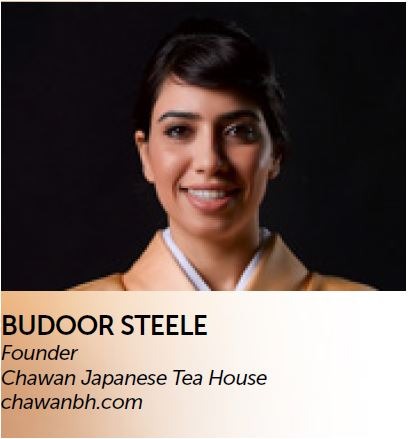

Recommended tea brand
Dilmah is unique. It was founded on passion, with a commitment to quality and authenticity in tea. It also bears a philosophy that goes beyond commerce in seeing business as a matter of human service. This ethos extends toward Dilmah’s leisure arm, Resplendent Ceylon, home to a collection of three boutique Relais & Châteaux resorts. The resorts — Ceylon Tea Trails, Cape Weligama and Wild Coast Tented Lodge — form an enchanting “Route de Bonheur (Happiness)” from tea fields to a beach and safari lodge.
Tea trends
The younger generation is seeking beverages that are low in caffeine and rich in antioxidants. There is no drink that compares to tea in terms of its myriad hues, aromas, flavors, textures and synergy with food. The need to escape daily stresses has also led to a rise in chai — a delicious, comforting blend of strong tea with dairy, almond or oat milk, with infusions of mint, pepper, chilli, star anise and other spices, herbs and roots for added flavor.
Food and tea
There is endless potential when it comes to pairing tea with food. Tea can elevate taste, offers natural goodness and is also functional because it can emulsify fat.
There must always be respect for tea in food pairing; honoring the terroir from which the tea originates provides an opportunity to either complement the flavors or create a
contrast, while offering guests the chance to explore the appearance, aroma and taste of the tea. Our three resorts have integrated this concept of tea and food pairing at the
afternoon high teas we serve.
Tea on the menu
Tea can sharpen the appetite and enhance ordinary dining experiences by creating a sense of occasion. There are plenty of ways in which tea can be incorporated into
menus, from appetizers to desserts. The tea infused dinner at Ceylon Tea Trails is a classic example of optimal ways tea can be part of the food menu.
Consumption in the Middle East
The latest research with YouGov showed that 66 percent of those who traveled to the UAE visited a restaurant/hotel for a luxury high tea in the past year, while 58 percent of high-income guests only look for luxury tea in their rooms. It further revealed that 34 percent of guests order a luxury tea whenever they go to a hotel.
Recommendations for food and tea pairing
White tea is a subtle, smooth and silky kind of tea. It pairs well with light-flavored food, such as salads, and just about any appetizer. It’s great for when you’re just about to have your first heavy meal of the day.
Black teas, like Earl Grey, lemon, peach and ginger, are frequently flavored with spices, flowers and fruits to give them that extra punch, making your regular black tea a little more interesting. When it comes to pairing with food, Earl Grey can be paired with Thai green curry, curry puffs and even Szechuan chicken dishes. Lemon tea, on the other hand, boasts a little tanginess. It is best paired with tandoori chicken, as the lemony flavor helps to bring out the tandoori taste. Within the green tea family, the most common notes are vegetative, fruity and smoky flavours. As you might observe, they’re all entirely different. Jasmine green tea has a fruity, fragrant aroma. It’s best enjoyed with steamed fish. Sencha green tea is also known as Japanese green tea and has a distinctive vegetative flavour, making it a great accompaniment to sashimi and green, creamy salads.
Moroccan mint green tea is perfect for those who want a lighter green tea profile. It’s refreshing and pairs well with chocolate flavored desserts due to the fact that it doesn’t compete too much with the
richness of chocolate.

Talking matcha
While tea trends differ based on region, we have noticed many new trends involving tea over the years, such as nitro tea and boba tea. However, matcha — Japanese powdered green tea — has created a steady buzz among consumers. Consequently, the appeal of matcha in numerous drinks and desserts has expanded beyond Japan. Unfortunately, however, misinformation about the health benefits and proper usage of matcha as a superfood has been circulating in the culinary industry. In my opinion, tea consumers should be educated on this. For instance, to benefit from its unique properties, the matcha has to be ceremonial grade made in Japan. Most importantly, it should not be mixed with any dairy.
Matcha is an essential part of my morning routine because of its health benefits. Unlike coffee, matcha is alkaline, gentler on the stomach and heals the gut. Start your day with matcha and dates, which are also considered superfoods, to give you an energy boost. In addition, matcha is a mood enhancer, and the L-Theanine in matcha will calm your mind, helping to relieve anxiety and restore balance and focus.
A perfect combination
The F&B industry should pay closer attention to its tea selection and offer teas that pair well with the food options. Comparable to wine — as its non-alcoholic sibling — tea can highlight the flavor of a dish or
completely offset it if it’s not carefully selected.
For example, matcha pairs well with foods such as dates, citrus fruits, berries, cream and white chocolate, while houjicha pairs well with flavors like dark chocolate, hazelnut or almond. A certified tea sommelier’s expertise lies in suggesting a tea that carefully matches the establishment’s position while it refines the culinary experience. We have a handful of certified tea sommeliers in the Middle East, myself included.
Understanding tea
Unfortunately, tea culture has not yet spread extensively in the Middle East. When it comes to hot teas, suggesting a tea-pairing menu with each dessert would encourage and guide customers to the right tea selection and deepen their understanding of various teas. Other than hot teas and tea-based lattes, cold brews add a refreshing selection to the menus of restaurants and cafes. In contrast, tea-based mocktails and cocktails can be a creative and fun way to introduce tea varietals to customers.














